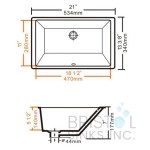Bathroom Fan Venting Through Soffit
Many homes have bathrooms that are located on the interior of the house, without any windows. In these cases, it is important to have a bathroom fan to ventilate the room and remove moisture.
Bathroom fans can be vented through the roof or through a soffit. Venting through a soffit is often the easier option, as it does not require cutting through the roof. However, there are a few things to keep in mind when venting a bathroom fan through a soffit.
First, the soffit must be large enough to accommodate the fan's ductwork. The ductwork should be at least 4 inches in diameter, and it should be made of a material that is resistant to moisture and heat.
Second, the soffit must be located in a place where it will not be blocked by insulation or other obstacles. The fan should be vented as close to the bathroom as possible, and the ductwork should be as short and straight as possible.
Third, the soffit must be properly sealed around the ductwork to prevent air leaks. Air leaks can allow moisture and heat to escape into the attic, which can lead to mold and mildew growth.
If you are considering venting your bathroom fan through a soffit, it is important to consult with a qualified contractor to ensure that the installation is done correctly.
Benefits of Venting Through a Soffit
There are several benefits to venting a bathroom fan through a soffit.
- It is an easier and less expensive option than venting through the roof.
- It does not require cutting through the roof, which can damage the shingles or tiles.
- It can help to improve the efficiency of the bathroom fan by reducing the amount of backpressure on the fan.
Drawbacks of Venting Through a Soffit
There are also a few drawbacks to venting a bathroom fan through a soffit.
- The soffit must be large enough to accommodate the fan's ductwork.
- The soffit must be located in a place where it will not be blocked by insulation or other obstacles.
- The soffit must be properly sealed around the ductwork to prevent air leaks.
Alternatives to Venting Through a Soffit
If you are unable to vent your bathroom fan through a soffit, there are a few other options available.
- You can vent the fan through the roof. This is a more difficult and expensive option, but it is the most effective way to ventilate a bathroom.
- You can install a fan that vents directly to the outside. This is a less effective option than venting through a soffit or roof, but it is still better than not having a fan at all.
Conclusion
Venting a bathroom fan through a soffit is a relatively easy and inexpensive way to improve the ventilation in your bathroom. However, it is important to make sure that the soffit is large enough to accommodate the fan's ductwork, that the soffit is located in a place where it will not be blocked by insulation or other obstacles, and that the soffit is properly sealed around the ductwork to prevent air leaks.

Everbilt 4 In To 6 Soffit Exhaust Vent Sevhd The Home

Adding A Bathroom Fan Fine Homebuilding

Bathroom Venting Through Soffit Greenbuildingadvisor

Bathroom Exhaust Vents In Your San Antonio Area Home Jwk Inspections

Do Your Exhaust Vents Terminate At Soffits Charles Buell Consulting Llc

Soffit Bath Fan Ventilation Exterior Inspections Internachi Forum

Way S To Fix Bath Fan At Ventilated Soffits

Bathroom Fan Vented In The Loft Hotdeals

Bathroom Soffit Vent

Sevzw Dundas Jafine Soffit Exhaust Vent White Amre Supply







